From being primarily associated with wetlands and woodlands the hadeda ibis has successfully expanded its range across much of the country even where it was formerly absent, and nowadays populations flourish even in urban areas. In suburbia it continues its association with water in the form of well-watered lawns, ponds and swimming pools.
Hadedas, as they are known locally, are relatively large birds (adults weigh about 1.25 kg, that is about 2.75 lbs) with impressively long bills that they use to find prey, including probing into soft ground, eating mostly insects and earthworms, and also molluscs and small reptiles. In keeping with their size, they have an impressively loud call, and the name “hadeda” is imitative of the multi-syllabic call.
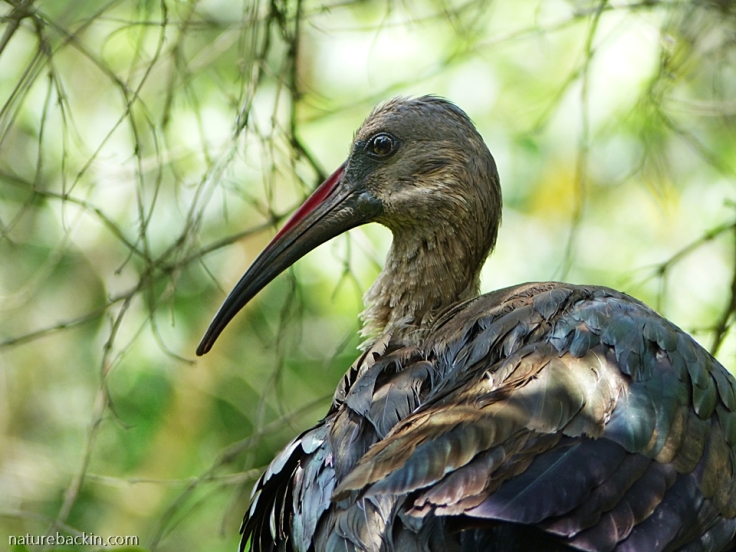
At first glance the hadeda ibis does not strike one as an average garden bird, however, they survive in cities and suburbs, despite being described as a wading bird associated with wetlands and wooded areas
It is surprising that such a large bird has been able to survive and thrive in urban and suburban areas, especially when considering that 100 years ago it was found in small numbers in localised areas and was considered to be a threatened species.
The hadeda used to be extensively hunted, so much so that it was declared a protected species in the former Transvaal in 1935 and in Natal in 1941. This protection contributed to its survival and its population numbers recovering.
In subsequent decades, not only did the hadeda ibis survive but it also extended its range. As former wetlands and forested areas were degraded making them less viable for many former inhabitants, alternatives opened up for hadedas in the form of irrigated land on farms, as well the well-watered lawns, playing fields and airstrips in urban areas, all providing environments where they could forage successfully. In addition, alien trees planted in these areas provided hadedas with nesting and roosting sites in areas where previously trees were relatively absent.

A pair of hadeda ibisis perched in a tree in our garden while preening after bathing in our garden pond
Hadedas are able to find water in suburban areas, including as mentioned in swimming pools, garden ponds and birdbaths. In our garden, on hot summer days, hadedas can spend a long time just standing in a bird bath keeping cool, but they also use them for drinking and if there is enough space, bathing.
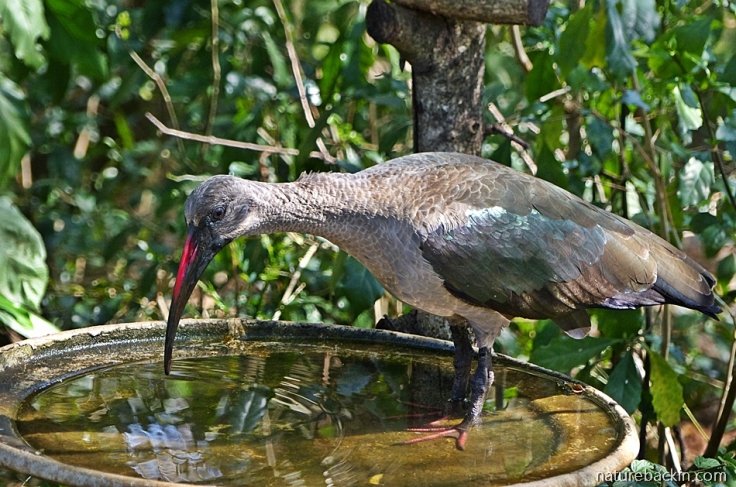
Keeping cool: A hadeda ibis standing in one of our birdbaths
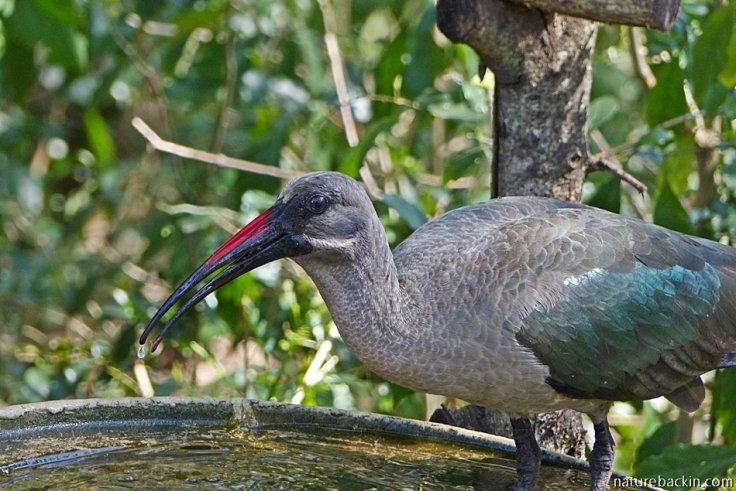
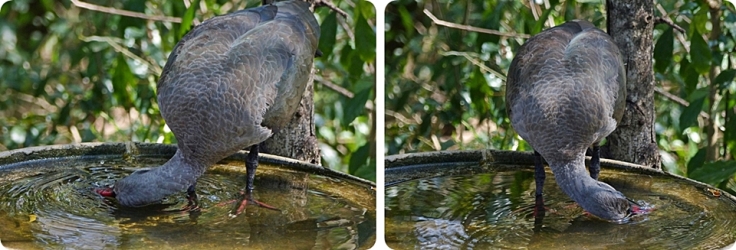
Drinking from a shallow birdbath requires a fair amount of ingenuity and flexibility

This resourceful bird even managed to have a thorough bath in the relatively small bird bath

It’s not unusual for two birds, either a breeding pair (as in this case) or a parent and offspring sharing the birdbath, sometimes standing together for considerable periods of time, though wary of my prying presence with the camera
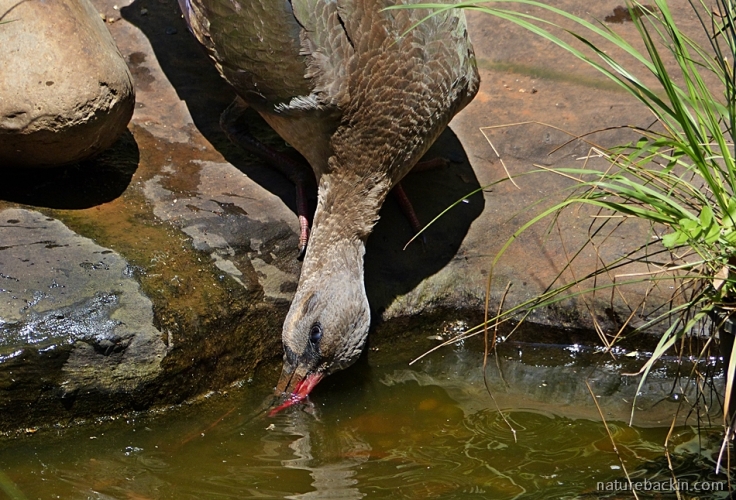
It’s much easier to drink from the deeper water of the pond. At the pond we have observed hadedas apparently catching tadpoles

Bathing in the pond can be a very social activity. I managed to photograph this pair without spooking them. When there are several birds together one of them invariable spots me trying to take photographs and alarms everybody into flying off

Taken from a window I photographed one bird splashily bathing while the other interrupts its bath to stretch its jaw (or yawn), something hadedas do fairly often during or after bathing. I have read that many birds do this jaw-stretch while preening but I gather that the reason for them doing this is not really understood

Bathing activity is quite a prolonged process and the birds seem to really enjoy it
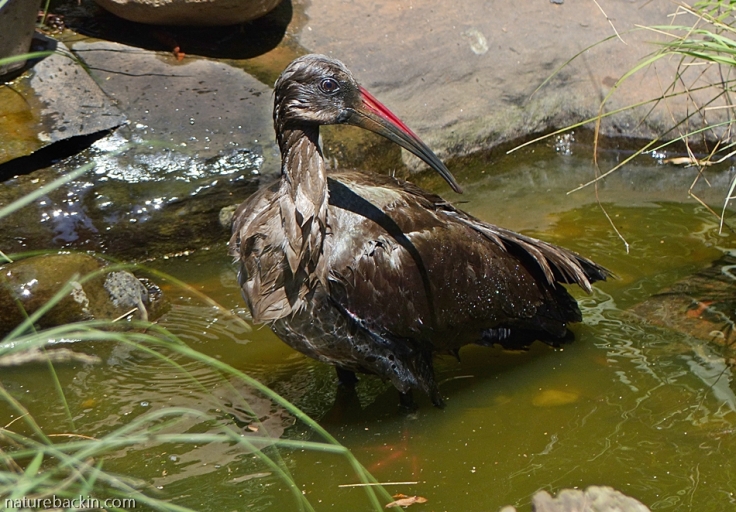
This bird after repeatedly bathing is totally soaked

Another wet hadeda can be seen doing the yawn or jaw-stretch while preening after its bath. (Part of the pond in the background is empty as a leak was in the process of being repaired.)
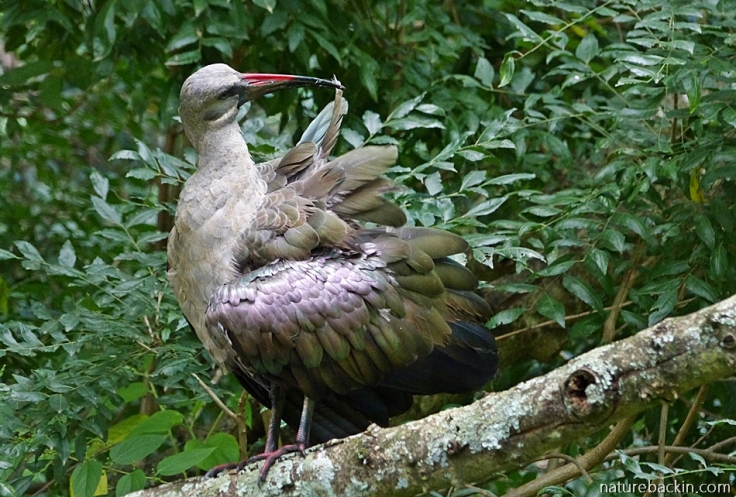
Probably the most important part of bathing is preening afterwards and oiling and conditioning feathers. This bird is zipping up the feather barbs to restore the proper functioning of the feathers
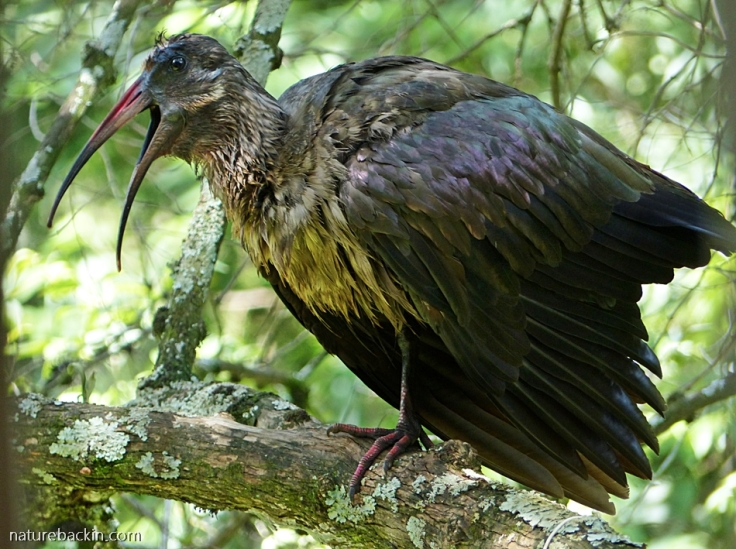
This hadeda ibis flew up into a tree to preen after bathing in the pond. I took this photo through a window and captured the still-wet bird doing a yawn or jaw-stretch while it was preening
Hadeda ibises are generally fairly tame in our garden, but they do seem to be much warier when bathing – perhaps they feel more vulnerable then? This vigilance is even more pronounced when there are several birds bathing in the pond. I have seen as many as six birds together in the pond while they bathe or preen, but their wariness has made it difficult to photograph them without frightening them off.
I did, however, manage to get some video clips of birds bathing in the pond, as can be seen in the video below. Included in the video is footage I took of the the bird in the last photograph (above) while it was preening.

Sources: Macdonald, I.A.W., Richardson, D.M. & Powrie, F.J. 1986. Range expansion of the hadeda ibis Bostrychia hagedash in southern Africa. South African Journal of Zoology, 21(4): 331-342; Roberts VII Multimedia PC Edition. 1997-2016 Southern African Birding. For details go to http://www.sabirding.co.za/roberts7/portal.html; Singh, Preshnee. 2014. Range expansion of the Hadeda Ibis (Bostrychia hagedash) in Pietermaritzburg, KwaZulu-Natal: An urban environment. MSc dissertation, University of KwaZulu-Natal.
Posted by Carol

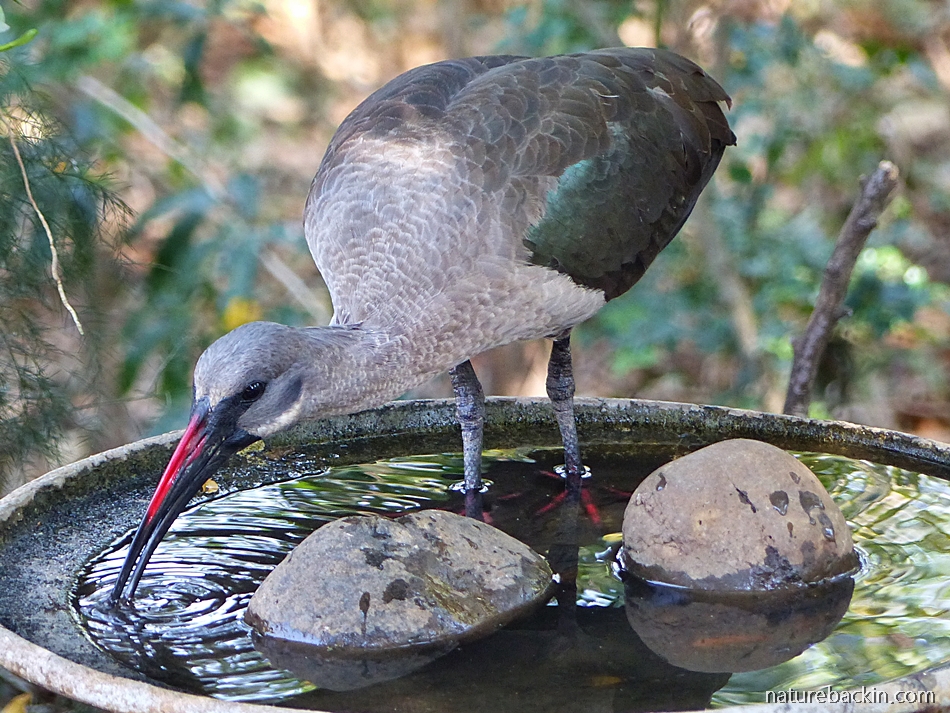







April 1, 2019 at 6:42 pm
Oh my gosh! Unbelievable! Thanks for sharing!
LikeLiked by 1 person
April 2, 2019 at 6:20 am
Pleasure to share – they are such fascinating birds. Thank you.
LikeLiked by 1 person
March 16, 2019 at 12:34 am
What a treat to see that video – thanks for sharing it!
LikeLiked by 1 person
March 17, 2019 at 8:10 pm
It was nice to have some birds who allowed me to sneak taking the video and good to share it. Thanks Eliza.
LikeLike
March 8, 2019 at 4:17 pm
I had no idea hadedas were once threatened. When I’ve been in S Africa they seemed to be everywhere. Good to hear of a bird adapting and thriving in this way. And wonderful photographs as ever!
LikeLiked by 1 person
March 8, 2019 at 8:17 pm
Thanks Sandra – I had not known that hadedas were once threatened until I did the reading for this post. As you say they seem to be established everywhere across South Africa, and it is an interesting success story.
LikeLiked by 1 person
March 8, 2019 at 8:34 am
What a beautiful and fascinating bird. Loved the video with all the sounds in the background and that final wing stretch was perfect! Thank you for sharing these great captures.
LikeLiked by 1 person
March 8, 2019 at 8:15 pm
Thanks Gunta – it was nice to share these photos of the hadedas focussing on their bathing and related behaviours. I was wondering how audible the birdsong and other sounds would be on the video. Yes the wing stretch was a gift 🙂
LikeLike
March 8, 2019 at 6:49 am
What fun. Good to see that they’ve been able to adapt to urban living.
LikeLiked by 1 person
March 8, 2019 at 7:57 pm
Yes they are entertaining to watch. I see that biologists refer to animals and birds who thrive in urban areas as “urban exploiters”. Its unfortunate that this descriptive phrase has a slightly pejorative edge to it, especially as wildlife that does well in urban areas is often disliked by many humans.
LikeLiked by 1 person
March 12, 2019 at 6:12 am
Urban exploiters? That’s not very nice.
LikeLiked by 1 person
March 8, 2019 at 5:34 am
I thoroughly enjoyed reading this post and am intrigued by your photographs. We have two pairs of hadedas that have been breeding in our garden for years and have watched them build their nests, raise their chicks and generally enjoy their raucous behaviour. Out of breeding season we can have up to ten of these birds roosting in our fig tree at night. They patrol the garden regularly but, although we have several birdbaths – including one like yours – I have never seen them actually in it. You have recorded some wonderful behaviour here!
LikeLiked by 1 person
March 8, 2019 at 7:12 pm
Thank you Anne. How remarkable to have two breeding pairs in your garden – a great compliment I should think. I suppose “your” birds have access to other sources of water (despite the drought?) and so don’t have to rely on your birdbaths?
LikeLike
March 9, 2019 at 5:23 am
There are some small dams on the edge of town, not far from where we live.
LikeLiked by 1 person
March 9, 2019 at 5:24 am
Perhaps that explains it then. Thanks.
LikeLike
March 8, 2019 at 5:18 am
As I read through your lovely post, I was listening to the laughing of some hadeda’s off in the distance. Thanks for all the info on these amazing birds.
LikeLiked by 1 person
March 8, 2019 at 7:09 pm
Thanks Debbie. They certainly do liven up the neighbourhood, and I agree that they are amazing birds and I can’t imagine not having them around.
LikeLike
March 8, 2019 at 5:04 am
Your blog is lovely Carol! I love watching our resident pair, sometimes with offspring as they move in a stately unhurried way foraging.
LikeLiked by 1 person
March 8, 2019 at 7:07 pm
Thanks Christeen. Yes they are stately, and its lovely to have a resident pair.
LikeLiked by 1 person
March 8, 2019 at 4:06 am
I love Hadedas!
LikeLiked by 1 person
March 8, 2019 at 7:04 pm
I do too, though I know that some don’t.
LikeLiked by 1 person
March 9, 2019 at 1:49 am
Seems most people don’t think much of them – I can only shake my head in silent disapproval when they complain about being woken by a hadeda alarm! 😀
LikeLiked by 1 person
March 9, 2019 at 5:10 am
I agree with you. I know even avid birders who dislike hadedas alongside the likes of those who play really loud music or video games, rev their motor bikes, and so on, and yet complain about noisy hadedas!
LikeLiked by 1 person
March 7, 2019 at 9:37 pm
Oh fabulous. How wonderful to have these birds sharing your garden.
LikeLiked by 1 person
March 8, 2019 at 7:03 pm
Yes it is wonderful to have them around – they definitely are enriching company.
LikeLike
March 7, 2019 at 8:11 pm
Almost Iconic up here in Gauteng. We have a large garden and they ”patrol” most mornings.
Lovely post, Carol, and the photos and video are smashing
LikeLiked by 1 person
March 8, 2019 at 7:01 pm
Thanks Arc – yes they are almost iconic and I enjoy having them around.
LikeLiked by 1 person